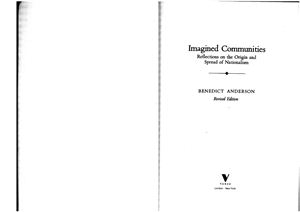[2nd, revised edition]. - London, New York: Verso, 1991. - 224
pp.
What makes people love and die for nations, as well as hate and kill in their name? While many studies have been written on nationalist political movements, the sense of nationality - the personal and cultural feeling of belonging to the nation - has not received proportionate attention. In this widely acclaimed work, Benedict Anderson examines the creation and global spread of the 'imagined communities' of nationality. Anderson explores the processes that created these communities: the territorialisation of religious faiths, the decline of antique kingship, the interaction between capitalism and print, the development of veacular languages-of-state, and changing conceptions of time. He shows how an originary nationalism bo in the Americas was modularly adopted by popular movements in Europe, by the imperialist powers, and by the anti-imperialist resistances in Asia and Africa. This revised edition includes two new chapters, one of which discusses the complex role of the colonialist state's mindset in the development of Third World nationalism, while the other analyses the processes by which all over the world, nations came to imagine themselves as old.
When it was first published in 1983, 'Imagined Communities' deservedly became a classic in the analysis of nationalism - and an excellent antidote to those who beat nationalist drums. As the new chapter (on the 'geobiography of the book') at the end of this edition outlines, the book has now been published in 30 countries and 27 languages.
Partly inspired by Anderson, the debates on nationalism have moved on considerably in the subsequent 23 years.
What makes people love and die for nations, as well as hate and kill in their name? While many studies have been written on nationalist political movements, the sense of nationality - the personal and cultural feeling of belonging to the nation - has not received proportionate attention. In this widely acclaimed work, Benedict Anderson examines the creation and global spread of the 'imagined communities' of nationality. Anderson explores the processes that created these communities: the territorialisation of religious faiths, the decline of antique kingship, the interaction between capitalism and print, the development of veacular languages-of-state, and changing conceptions of time. He shows how an originary nationalism bo in the Americas was modularly adopted by popular movements in Europe, by the imperialist powers, and by the anti-imperialist resistances in Asia and Africa. This revised edition includes two new chapters, one of which discusses the complex role of the colonialist state's mindset in the development of Third World nationalism, while the other analyses the processes by which all over the world, nations came to imagine themselves as old.
When it was first published in 1983, 'Imagined Communities' deservedly became a classic in the analysis of nationalism - and an excellent antidote to those who beat nationalist drums. As the new chapter (on the 'geobiography of the book') at the end of this edition outlines, the book has now been published in 30 countries and 27 languages.
Partly inspired by Anderson, the debates on nationalism have moved on considerably in the subsequent 23 years.

